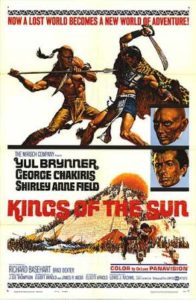 How a lost world became a new world of adventure!
How a lost world became a new world of adventure!
The 1950s and 60s were the time of the epic. Television was growing by leaps and bounds and movie studios were on the run for anything to combat the incursion of that little glowing box. So in addition to a veritable cornucopia of format changes – the most popular being cinemascope- the pictures got bigger to present images and themes economically unworkable for their television counterparts.
The more popular of these films are the likes of Ben Hur, The Ten Commandments, Quo Vadis, and Cleopatra. But there are equally ambitious films from the period which simply haven’t remained in the public’s vision.
Kings of the Sun is one of these later examples.
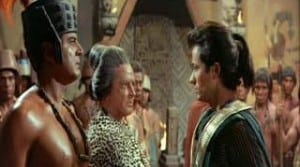 Rather than focus on yet another Authurian or better still a Biblical tale, Kings of the Sun focuses on a less popular setting, that of the Maya. (Evidently Robert Taylor and Charlton Heston were busy, hence the change in locale.) There are only a handful of films focusing on this fascinating civilization, with the only other that readily comes to mind being Mel Gibson’s Apocalypto.
Rather than focus on yet another Authurian or better still a Biblical tale, Kings of the Sun focuses on a less popular setting, that of the Maya. (Evidently Robert Taylor and Charlton Heston were busy, hence the change in locale.) There are only a handful of films focusing on this fascinating civilization, with the only other that readily comes to mind being Mel Gibson’s Apocalypto.
The story has some legs as well, and is at least not merely a thin patina for large-scale battle scenes. We’ve actually got a real plotline, though it holds up very poorly against any kind of historical or logical knowledge.
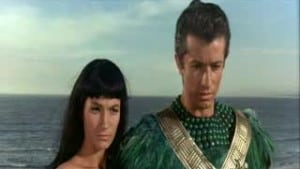 George Chakiris is Balam, King of a Mayan Nation. As the film opens his country is overrun by Leo Gordon – in the role of rival Mayan King Hunac Ceel. So good King Balam looks about and takes what is left of his army to the sea. Here the absorb another band- I won’t say nation because they are not that- and together the set sail across the Gulf of Mexico. Part of this absorbed band is Ixchel, (Shirley Anne Field) who is the daughter of the groups leader. Balam promises his hand in marriage to her in exchange for their allegiance.
George Chakiris is Balam, King of a Mayan Nation. As the film opens his country is overrun by Leo Gordon – in the role of rival Mayan King Hunac Ceel. So good King Balam looks about and takes what is left of his army to the sea. Here the absorb another band- I won’t say nation because they are not that- and together the set sail across the Gulf of Mexico. Part of this absorbed band is Ixchel, (Shirley Anne Field) who is the daughter of the groups leader. Balam promises his hand in marriage to her in exchange for their allegiance.
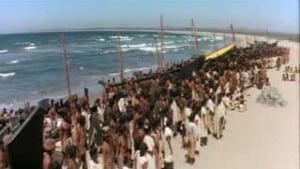 So across the sea (or gulf as is the case here) until they hit what presumably would be Louisiana. They set up shop and begin building a new kingdom right on the coast, including a great step temple for their sacrificial rites.
So across the sea (or gulf as is the case here) until they hit what presumably would be Louisiana. They set up shop and begin building a new kingdom right on the coast, including a great step temple for their sacrificial rites.
However, they’ve been spotted by Chief Black Eagle (Yul Brynner) who plans to push their fledgling colony back into the sea. However, after Black Eagle’s capture and near-sacrifice by Balam’s Mayan’s, Balam releases him and for a short time the two peoples life together in peace. After a while cracks begin to appear and Black Eagle and his tribe move out, again to live on their own.
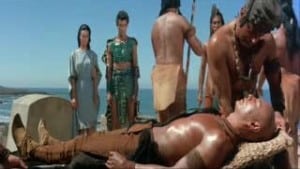 Almost on queue Hunac Ceel’s rampaging Mayans are spotted offshore, having finally tracked Balam and launch what is surely the largest amphibious assault in the history of the Mayan nation- real or imagined. In an unsurprising move, Black Eagle returns with his warriors to save the day, though at the cost of his life.
Almost on queue Hunac Ceel’s rampaging Mayans are spotted offshore, having finally tracked Balam and launch what is surely the largest amphibious assault in the history of the Mayan nation- real or imagined. In an unsurprising move, Black Eagle returns with his warriors to save the day, though at the cost of his life.
It plays well aesthetically on screen, with many panoramic shots of the Mexican landscape and wide shots of armies in motion and the like. Kings of the Sun was definitely a big budget release and it shows on the screen- excluding one shot where actors clearly are falling onto a sand-covered mattress.
But somehow the film never gets out of second gear. The score by Elmer Bernstein is loud, redundant, and uninteresting. Though his scores stereotypically fare best in wide open spaces (think The Magnificent Seven) here he is clearly out of his element.
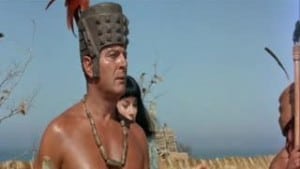 Other challenges come up in the logic and casting of the picture. The casting is the typical for the time mélange of folks playing races and ethos which they shouldn’t. Richard Basehart as a Mayan Shaman? Only Brynner himself manages to look as he should. The balance of the cast looks rather staid and almost Shakespearean in their demeanor.
Other challenges come up in the logic and casting of the picture. The casting is the typical for the time mélange of folks playing races and ethos which they shouldn’t. Richard Basehart as a Mayan Shaman? Only Brynner himself manages to look as he should. The balance of the cast looks rather staid and almost Shakespearean in their demeanor.
Chakiris is not only miscast by ethnicity, but also by personality and type. Throughout the picture, he looks for the most part like an uninterested teenager. From what is onscreen it is impossible to buy into any ability he may have as a ruler, much less as a warrior.
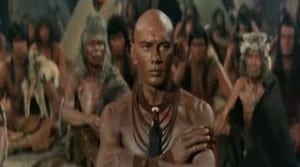 Then there are the numerous disconnects on the logic side. From my memory, the Mayans were a great civilization, though not a particularly adept seafaring one. That aside, there is the presumed language issues in a Mayan nation meeting a North American native nation. It would also appear that the weaponry, both in style and manufacture, are not accurate to the period. Also, the Frank Lloyd Wright in me suspects that a step pyramid in the surf would not be a good idea from a stability point of view.
Then there are the numerous disconnects on the logic side. From my memory, the Mayans were a great civilization, though not a particularly adept seafaring one. That aside, there is the presumed language issues in a Mayan nation meeting a North American native nation. It would also appear that the weaponry, both in style and manufacture, are not accurate to the period. Also, the Frank Lloyd Wright in me suspects that a step pyramid in the surf would not be a good idea from a stability point of view.
But again, perhaps looking for 2014 historical accuracy in a 1963 film is a misnomer to start. Running at close to two hours, Kings of the Sun seems a bit bloated and could use a touch of tightening up which would result in a much improved finished product. Especially in the first few reels, there is a tremendous amount of exposition.
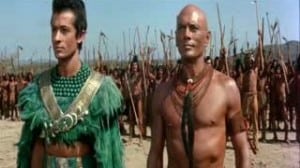
There are two nice sub-threads running throughout the picture. The first is of cultural assimilation and how different cultures can and should appreciate their differences and learn what they can from each other- either for their own execution or simple awareness.
The second sub-thread goes to the need for change and questioning values for continued legitimacy. Balam openly questions his people’s religion and the rather random brutality of it before ultimately dismissing it entirely.
A nice thought, but also rather unrealistic. Unless you are a Brynner die-hard fan, you can most likely skip this one. Sadly, he alone gives a tremendous effort and great performance in a lost cause.
“Almost on queue”? A queue is a bunch of people waiting in line, or a Chinese pigtail from the Manchu dynasty. I assume you meant “cue.”
Sounds like an interesting movie. I’ll have to see if I can find and download a copy.